OLDSMOBILE BRAVADA 1998 Owners Manual
Manufacturer: OLDSMOBILE, Model Year: 1998, Model line: BRAVADA, Model: OLDSMOBILE BRAVADA 1998Pages: 380, PDF Size: 19.2 MB
Page 301 of 380

Name
BIU LP
AIC
RAP
02
IGN B
DRL
FOG LP
IGN
A
STUD #2
PARKLP
LR PRK
IGN C
HTDSEAT
Usage
Back-up Lamps
Air Conditioning
Retained Accessory Power
Oxygen Sensor
Column Feed,
IGN 2, 3, 4
Daytime Running Lamps
Fog Lamps
Starting and Charging
IGN 1
Accessory Feeds, Electric Brake
Parking Lamps
Left Rear Parking Lamps
Starter Solenoid. Fuel PLIIIIP,
PRNDL
Heated Seat
Name
ATC
RRDFOG
HVAC
TRCHMSL
RR WIW
CRANK HAZLP
VECHMSL
HTDMTR
STOPLP
TBC
Usage
Active Transfer Case
Rear Defogger HVAC System
Trailer Center High-Mount
stop Lamp
Rear Window Wiper
Clutch Switch, NSBU Switch
Hazard Lamps
Vehicle Center High-Mount
Stop Lamp
Heated Mirror
Stoplan1ps
Truck Body Computer
ProCarManuals.com
Page 302 of 380
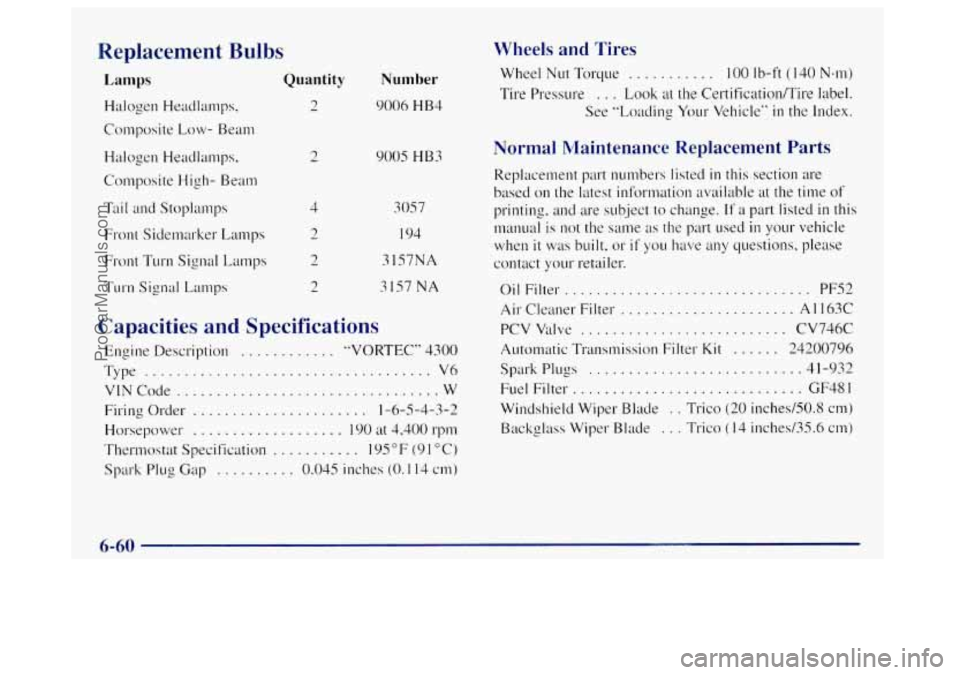
Replacement Bulbs
Lamps
Halogen Headlamps,
Composite Low- Beam
Halogen Headlamps.
Composite High- Beam
Tail and Stoplamps
Front Sidemarker Lamps
Front Turn Signal Lamps
Turn Signal Lamps
Quantity
2
2
4
Number
9006 HB4
9005 HB3
305 7
I94
31S7NA
3157
NA
Capacities and Specifications
Engine Description ............ "VORTEC" 4300
Type
.................................... V6
VINCode ................................. W
Firing Order
...................... 1-6-5-4-3-2
Horsepower
................... I90 at 4,400 rpm
Thermostat Specification
........... 1% "F (9 1 "C)
Spark Plug Gap
.......... 0.045 inches (0. I 14 cm)
Wheels and Tires
Wheel Nut Torque ........... 100 Ib-ft ( I40 Nem)
Tire Pressure . , . Look at the Certification/Tire label.
See "Loading Your Vehicle"
in the Index.
Normal Maintenance Replacement Parts
Replacement part numbers listed in this section are
based on the latest information available at the time
of
printing, and are subject to change. If a part listed in this
manual is not the same
as the part used in your vehicle
when
it was built, or if you have any questions, please
contact your retailer.
Oil Filter.
.............................. PFS2
Air Cleaner Filter ...................... A 1 163C
PCV Valve .......................... CV746C
Automatic Transmission Filter
Kit ...... 24200796
Spark P~LI~S
........................... 4 1-932
Fuel Filter ............................. GF48 1
Windshield Wiper Blade . . Trico (20 inchedS0.S crn)
Backglass Wiper Blade
... Trico (14 inched35.6 cm)
6-60
ProCarManuals.com
Page 303 of 380
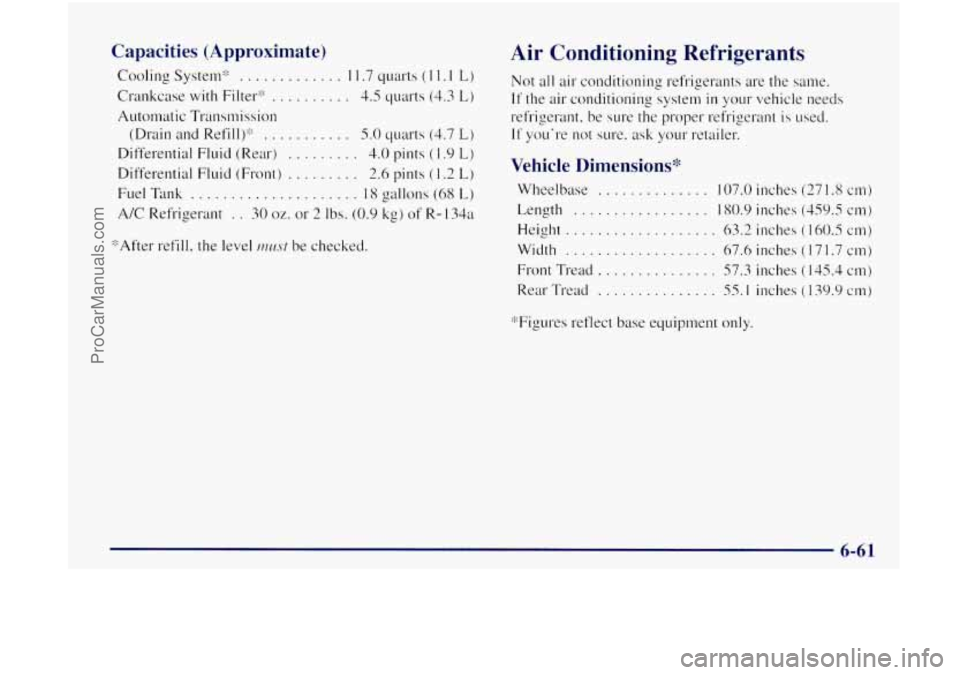
Capacities (Approximat-e)
Cooling System'" ............. 1 1.7 quarts (1 I, I L)
Crankcase with Filter'" .......... 4.5 quarts (4.3 L)
Automatic Transmission
(Drain and Refill):':
........... 5.0 quarts (4.7 L)
Differential Fluid (Rear) ......... 4.0 pints ( I .9 L)
Differential Fluid (Front) ......... 2.6 pints ( 1.2 L)
Fuel Tank ..................... 18 gallons (68 L)
A/C Refrigerant . . 30 oz. or 2 Ibs. (0.9 kg) of R- 13421
'"After refill, the level
m~st be checked.
Air Conditioning Refrigerants
Not all air conditioning refrigerants are the same.
If the air conditioning system in your vehicle needs
refrigerant. be
SLIE the proper refrigerant is sed.
I1 you're not sure. ask your retailer.
Vehicle Dimensions*
Wheelbase .............. 107.0 inches (27 1.8 cm)
Length ................. 180.9 inches (459.5 cm)
Height
................... 63.2 inches ( 160.5 cm)
Width ................... 67.6 inches ( 17 1.7 an)
Front Tread
............... 57.3 inches ( 145.4 cm)
Rear Tread ............... 55.1 inches ( 139.9 cm)
'"Figures reflect base equipment only.
6-61
ProCarManuals.com
Page 304 of 380
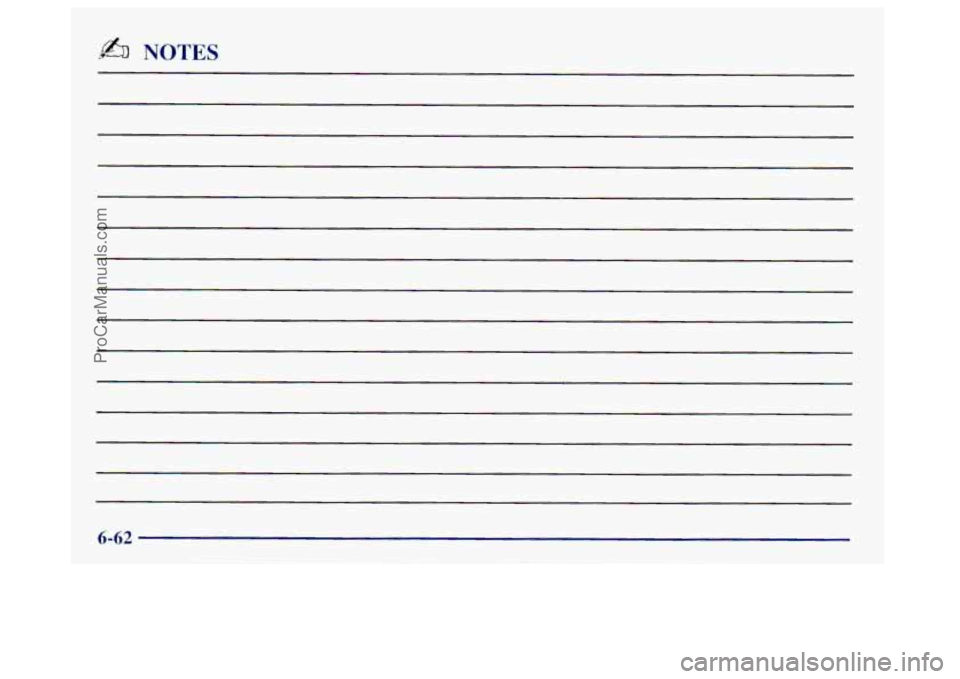
b NOTES
6-62
ProCarManuals.com
Page 305 of 380

a Section 7 Maintenance Schedule
This section covers the maintenance required for your vehicle. Your vehicle needs these services tQ retain its safety.
dependability and emission control performance.
7-2
7-4
7-5
7-5
7-6
7-6
Introduction
Part
A: Schecluled Maintenance Service
Short Trip/City Definition
Short Trip/City Intervals
Long Trip/Highway Definition
Long Trip/Highway Intervals 7-7 7-27
7-39
7-43
7-4s
7-47
Short Trip/City Maintenance Schedule
Long Trip/Highway Maintenance Schedule
Part
B: Owner Checks and Services
Part C: Periodic Maintenance Inspections
Part
D: Recommended Fluids and Lubricants
Part
E: Maintenance Record
-
ProCarManuals.com
Page 306 of 380

Introduction
IMPORTANT:
KEEP ENGINE OIL
AT THE PROPER
.VEL AND CHANGE
RECOMMENDED
11
.I
Your Vehicle and the EnvironmcC
Proper vehicle maintenance not only helps to keep your
vehicle
in good working condition, but also helps the
environment.
All recommended maintenance procedures
are important. Improper vehicle maintenance can even
affect the quality of the air we breathe. Improper fluid
levels or the wrong tire inflation can increase
the level
of emissions from your vehicle. To help protect our
environment. and to keep your vehicle
in good
condition, please maintain your vehicle properly.
How This Section is Organized
The remainder of this section is divided into five parts:
“Part A: Scheduled Maintenance Services” shows
what to have done and how often. Some
of these
services can be complex,
so unless you are technically
qualified
and have the necessary equipment, you should
let your retailer’s service department or another
qualified service center do these
jobs.
7-2
ProCarManuals.com
Page 307 of 380
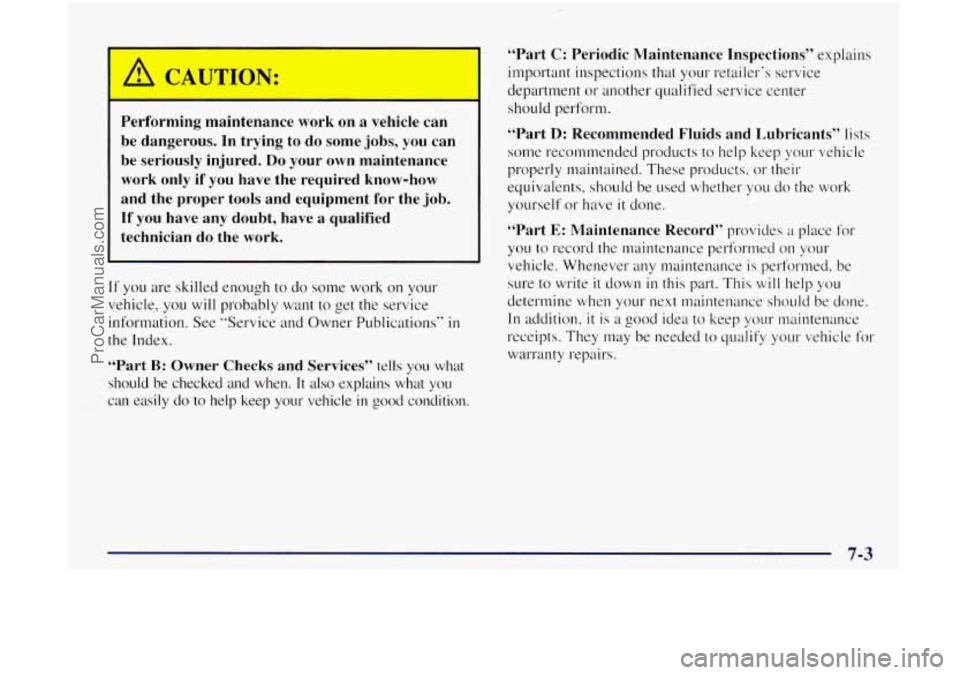
Performing maintenance work on a vehicle can
be dangerous. In trying to do some jobs,
you can
be seriously injured.
Do your own maintenance
work only if
you have the required know-how
and the proper tools and equipment for the job.
If you have any doubt, have a qualified
technician do the work.
If you are skilled enough to do some work on your
vehicle, you
will probably want to get the service
information. See “Service and Owner Publications“
in
the Index.
“Part B: Owner Checks and Services” tells you what
should be checked and when.
It also explains what you
can easily
do to help keep your vehicle in good condition.
“Part C: Periodic Maintenance Inspections” explains
important inspections that
your retailer’s service
department or another qualified service center
should perform.
“Part D: Recommended Fluids and Lubricants” lists
some recommended products to help keep your vehicle
properly maintained. These products,
or their
equivalents, should be used whether you do the work
yourself or have
it clone.
“Part E: Maintenance Record” provides a place lor
you to record the maintenance performed
on your
vehicle. Whenever any maintenance is perfornled, be
sure to write
it down in this part. This will help you
determine when your next maintenance
should be clone.
In acldition, it is a good idea to keep your maintenance
receipts. They may be needed to qualify your vehicle
for
warranty repairs.
7-3
ProCarManuals.com
Page 308 of 380

Part A: Scheduled Maintenance
Services
Using Your Maintenance Schedule
We at General Motors want to help you keep your vehicle
in good working condition. But we don‘t know exactly
how you’ll drive
it. You may drive very short distances
only a few times
a week. Or you may drive long distances
all
the time in very hot, dusty weather. You may use your
vehicle
in making deliveries. Or you may drive it to work,
to do en-ands or
in many other ways.
Because of
all the different ways people use their
vehicles, maintenance needs vary. You may even need
more frequent checks and replacements than
you’ll find
in the schedules in this section. So please read this
section and note how you drive.
If you have any
questions on how to keep your vehicle
in good
condition, see your
GM retailer.
This part tells you the maintenance services you should
have done and
when you should schedule them. If you
go to your retailer for your service needs, you’ll know
that GM-trained and supported service people
will
perform the work using genuine GM parts. The proper fluids and lubricants to use are listed
in
Part D. Make sure whoever services your vehicle uses
these.
All parts should be replaced and all necessary
repairs done before you
or anyone else drives the vehicle.
These schedules are for vehicles
that:
0 carry passengers and cargo within recommended
limits. You
will find these limits on your vehicle’s
Certification/Tire label. See “Loading Your Vehicle”
in the Index.
0 are driven on reasonable road surfaces within legal
driving limits.
0 use the recommended fuel. See ”Fuel” in the Index.
Selecting the Right Schedule
First you’ll need to decide which of the two schedules is
right for your vehicle. Here’s how to decide which
schedule to follow:
ProCarManuals.com
Page 309 of 380
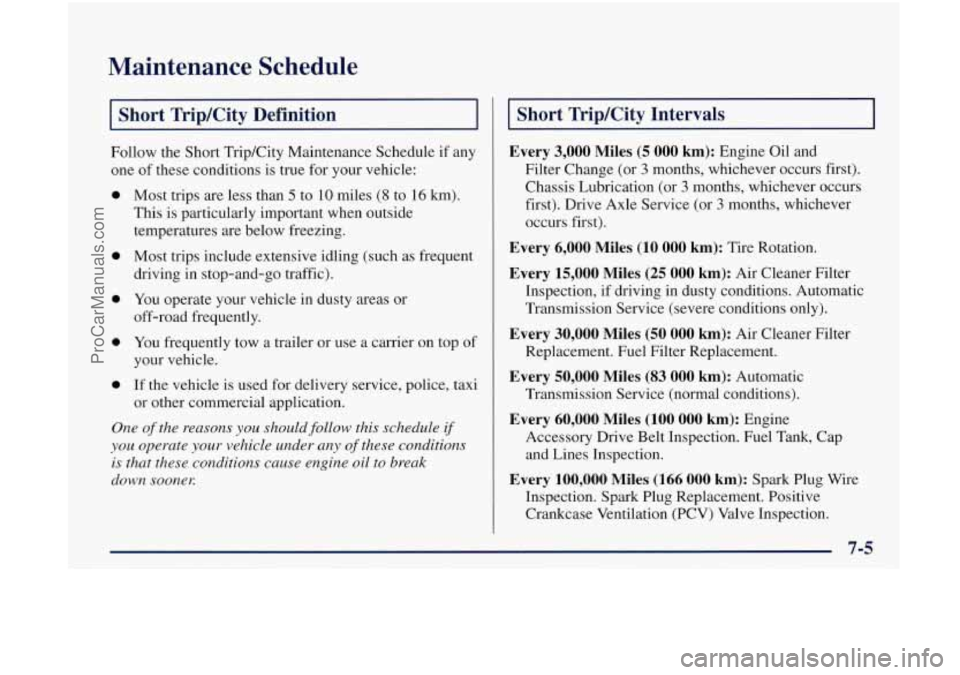
Maintenance Schedule
I Short Trip/City Definition
Follow the Short Trip/City Maintenance Schedule if any
one of these conditions is true for your vehicle:
0
0
0
0
0
Most trips are less than 5 to 10 miles (8 to 16 km).
This is particularly important when outside
temperatures are below freezing.
Most trips include extensive idling (such as frequent
driving in stop-and-go traffic).
You operate your vehicle in dusty areas or
off-road frequently.
You frequently tow a trailer or use a carrier on top of
your vehicle.
If
the vehicle is used for delivery service, police, taxi
or other commercial application.
One of the reasons you should follow this schedule if
you operate your vehicle under any of these conditions
is that these conditions cause engine oil to break
down sooney:
Short Trip/City Intervals
Every 3,000 Miles (5 000 km): Engine Oil and
Filter Change (or
3 months, whichever occurs first).
Chassis Lubrication (or
3 months, whichever occurs
first). Drive Axle Service (or
3 months, whichever
occurs first).
Every 6,000 Miles (10 000 km): Tire Rotation.
Every 15,000 Miles (25 000 km): Air Cleaner Filter
Inspection, if driving in dusty conditions. Automatic
Transmission Service (severe conditions only).
Every 30,000 Miles (50 000 km): Air Cleaner Filter
Replacement. Fuel Filter Replacement.
Every 50,000 Miles (83 000 km): Automatic
Transmission Service (normal conditions).
Every 60,000 Miles (100 000 km): Engine
Accessory Drive Belt Inspection. Fuel Tank, Cap
and Lines Inspection.
Every 100,000 Miles (166 000 km): Spark Plug Wire
Inspection. Spark Plug Replacement. Positive
Crankcase Ventilation (PCV) Valve Inspection.
7-5
ProCarManuals.com
Page 310 of 380
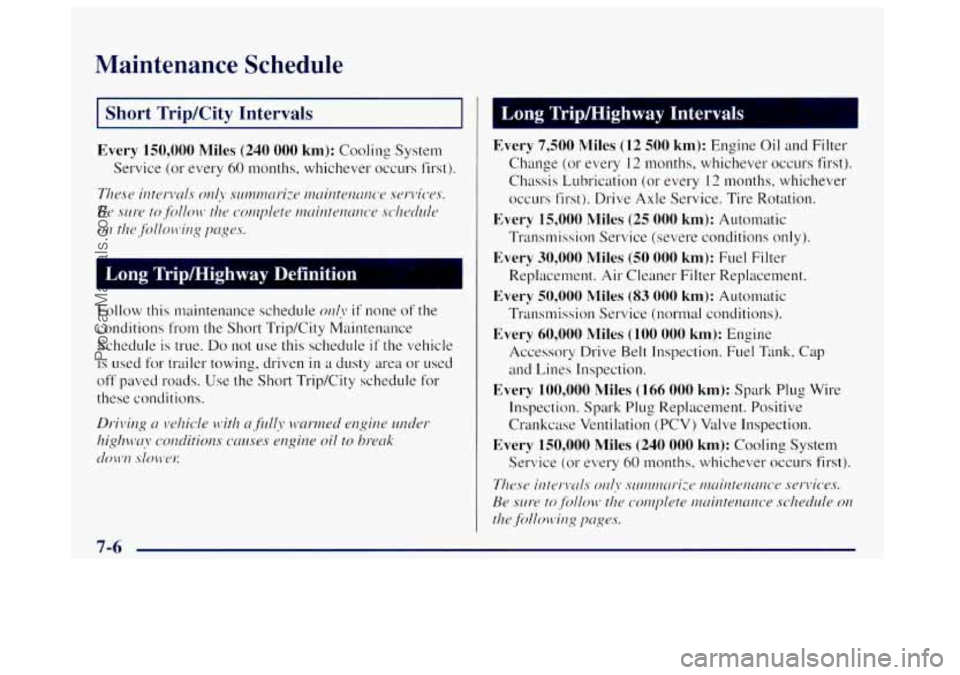
Maintenance Schedule
I Short TripKity Intervals I
Every 150,000 nliles (240 000 km): Cooling System
Service (or every
60 months, whichever occurs first).
1 Long Tripmighway Definition
Follow this maintenance schedule orll\. if none of the
conditions from the Short Trip/City Maintenance
Schedule is true.
Do not use this scl1edule if the vehicle
is used for trailer towing, driven in a dusty area or used
off paved roads. Use the Short Trip/City schedule for
these conditions.
Long Tripmighway Intervals
Every 7,500 Miles (12 500 km): Engine Oil and Filter
Change (or every
I2 months, whichever occurs first).
Chassis Lubrication (or every
12 months, whichever
occurs first). Drive Axle Service. Tire Rotation.
Every 15,000 Miles (25 000 km): Automatic
Transmission Service (severe conditions only).
Every 30,000 Miles (50 000 km): Fuel Filter
Replacement.
Air Cleaner Filter Replacement.
Every 50,000 Miles (83 000 km): Automatic
Transmission Service (normal conditions).
Every 60,000 Miles (100 000 km): Engine
Accessory Drive Belt Inspection. Fuel Tank, Cap
and Lines Inspection.
Every 100,000 Miles (166 000 km): Spark Plug Wire
Inspection. Spark Plug Replacement. Positive
Crankcase Ventilation (PCV) Valve Inspection.
Every 150,000 Miles (240 000 km): Cooling System
Service (or every
60 months, whichever occurs first).
Tlrosc) iuter.\uls o,rl\* .\'lttlllllcrri:o l1lui/1~cn~rnco wr\.ic-e.s.
Br strw to,fi)llon* tho cw11plett-' nlcrintencrm-e schdule on
tl1e~fi~llol-t:iug pcrgc~s.
7-6
ProCarManuals.com